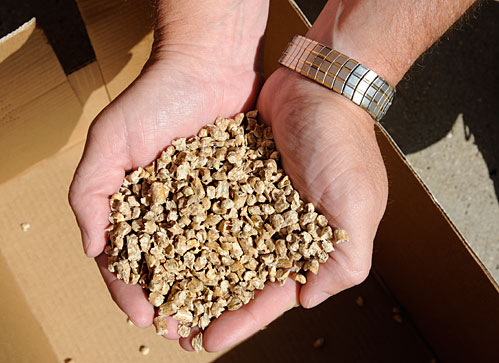July 15, 2010

Photo by Bob Elbert.
Tests to assess feasibility of mixing biomass and coal to power university
by Diana Pounds
Right about now, your university office is being partially heated, cooled and powered by wood pellets. The pellets, mixed with coal, are burning in two Iowa State boilers July 15 as part of a series of tests that utilities staff are conducting over several weeks.
The tests will help officials assess the feasibility of replacing some coal with biomass, which is considered a cleaner fuel source, says Jeff Witt, assistant director of utilities.
"We're doing this to see what other alternative energy sources are feasible," Witt said. "We'll be assessing both the environmental and economic impacts of using these sources."
This week's test involves a 10 percent pellet, 90 percent coal blend. Officials tested coal mixed with 5 percent wood pellets two weeks ago. The university has Iowa Department of Natural Resources' approval to try blends that include wood pellets or chips in quantities as high as 20 percent.
The tests may take up to three months. Initial tests involve burning the various coal-wood blends in 24-hour experiments.
Suppliers help fund tests
"We're looking to see how the materials handle, how we get it into the boilers, whether it plugs things up, that kind of thing," Witt said.
"Stack" tests come next and involve running blends through the boilers once again to test for air emissions.
All that testing would normally carry about a $65,000 price tag, Witt said. But the Rocky Mountain Pellet Co., Walden, Colo., and Nextgen Biofuels, Underwood, Iowa, are supplying the fuels (wood pellets and chips) at no cost. Iowa State will foot the estimated $23,000 bill for transportation costs and also will pay for all emissions testing.
Beetle-decimated Colorado pines
The wood for the experiments comes from Colorado pine trees ravaged by pine beetles. Some 3 million acres of trees in Colorado and southern Wyoming have fallen victim to the beetle, which has been eating through forests for more than a decade.
Adding wood as a fuel source would be more costly than sticking solely with coal, Witt said. At current prices, wood pellets or chips are approximately twice as expensive as coal.
"But we could do better on prices with a longer term contract," Witt said.
"There's a fair amount of interest in using more biomass and less coal," he added. "These tests will help us determine what we can do and what makes sense."